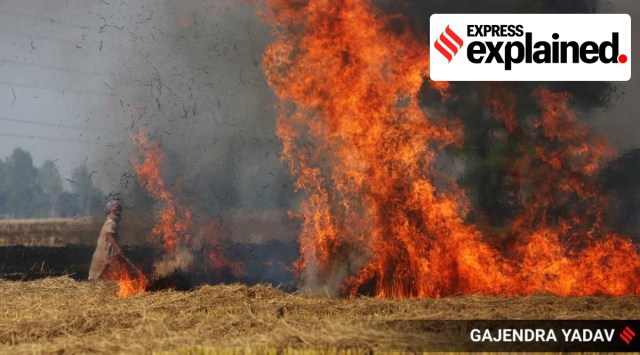Can halting kiln operations during the stubble burning period in Punjab check pollution?
Normally, kilns remain operational for 6-7 months in a year. So, closing them during paddy harvesting from October to December, when there is already air pollution due to stubble burning, would be an ideal situation.
 Stubble burning cases have already begun in the state with the harvesting of paddy. (File)
Stubble burning cases have already begun in the state with the harvesting of paddy. (File)When the stubble burning cases have already begun in the state with the harvesting of paddy, the Punjab government can control the pollution level to a large extent during paddy harvesting followed by stubble burning by halting the operations of brick kilns in the state. Can stopping the operation of kilns for a couple of months is possible without harming the interests of the kiln businesses and how can it contribute to keeping the Air Quality Index (AQI) under control, The Indian Express explains.
Why closing brick kilns during paddy harvesting season will not affect their businesses
Normally the kilns remain operational for 6-7 months in a year except for some exceptional cases where kiln owners even run them for 8 months in a year. So closing these during paddy harvesting and post paddy harvesting for 3-4 months from October to December when there is already a lot of air pollution taking place due to huge stubble burning would be an ideal situation. Nearly 200 to 250 people are dependent on a kiln for their living and if a system is created then they would be aware of the operational months of these kilns. Hoshiarpur-based brick Kiln owner of Tata Bricks, Shiv Walia said that in the National Capital Region (NCR) Delhi these are not operational in the winter months.
Did the government do it before?
In 2018 Punjab Pollution Control Board (PPCB) ordered of halting the operations of Brick kilns for four months from October 1, 2018, to January 2019 to check the air pollution level during paddy season and the winters month in Punjab and then in December 2018, the department of Science and Technology and Environment Punjab, on the directions of National Green Tribunal (NGT) had allowed operating those Kilns which were upgraded with new technology and certified by Science and Technology department.
What was the AQI of Punjab in that year during the stubble burning period?
According to the PPCB in 2018 stubble burning started in Punjab on September 21. From September 21 to October 21 that year 10,813 field fires were recorded in Punjab. And according to Central Pollution Control Board (CPCB), Punjab’s main cities including Amritsar, Jalandhar, Bathinda, Ludhiana, Mandi Gobindgarh, Khanna, Patiala and Rupnagar have recorded satisfactory to Moderate AQI on most of the days barring a couple of days when Mandi Gobindgarh, Amritsar and Ludhiana recorded poor AQI for some hours in that one month. While the National Capital’s AQI had remained in the poor category for several days during this period then. RSMP remained between 0-55 /cubic meter (mg/cm) in the air is considered to be good quality air and it is permissible/satisfactory up to 100 RSPM. The moderate limit of AQI is between 101 to 2o0 RSPM, Poor between 200 to 300, Very Poor 300 to 400 and Severe between Above 400 AQI.
Even the Ambient AQI at the rural stations (as the stubble fires take place in the rural areas) under the National Ambient Monitoring Programme (NAMP) NAMP had remained satisfactory to Moderate at most of the rural stations in September and October 2018, as per the records of the PPCB.
How kilns can reduce pollution
In Punjab, there are 2800 kilns out of which nearly 2100 are operational. And all the operational kilns are upgraded to ‘zigzag’ technology, which minimises the pollution emission to 70% as compared to old technology. PPCB officials said that this has reduced the emission of Carbon Dioxide (CO2) into the air by 4-lakh tonnes by upgrading the kilns.
A kiln is run on coal and a single operation needs around 135 to 150 tonnes of coal. When all 2100 kilns run during October and November when stubble burning takes place then with a single operation, which lasts for around a month, this kiln will burn between 2.83 lakh tonnes to 3.15 lakh tonnes of coal and if they remain operational all winter months then the amount would be much more.
PPCB officials said that not only stubble burning is responsible for poor AQI but industrial, and vehicular pollution is also largely responsible.
According to Science and Technology department, new technology has reduced the pollution level but still, their operation must be stopped during these months when stubble burning takes place.
Experts said that in winters the wind flow is slow at 8 to 10 Km/hour and the polluted air gets accumulated instead of dispersing out.
Punjab Brick Kiln Owner Association President Harmesh Mohi said that they have no objection if the government wants to halt the operation during the winter months.
- 01
- 02
- 03
- 04
- 05






































